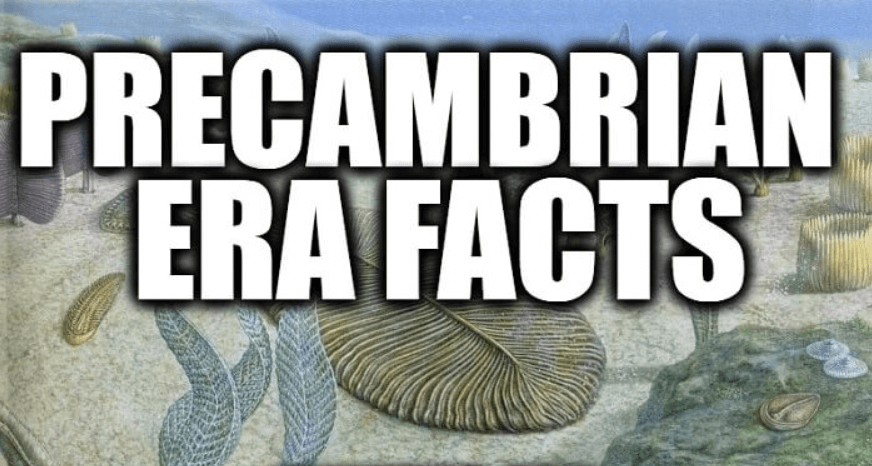The PreCambrian Era is a period of Earth’s history that spans over 4 billion years. Learn about the rock types, fossils, and Earth’s surface during this time and discover what we know about this mysterious era.

PreCambrian Era; The oldest rocks that contain fossils of distinct animals are known as the Cambrian rocks (from Cambria, the Latin word for Wales), and the fossils in them prove that such animals existed during the period that these rocks were being formed.
In many parts of the world, however, these Cambrian rocks rest on thick beds of rock that do not contain such fossils, which proves that they must be even older. They are therefore called the Pre-Cambrian rocks (“pre” means “before”). Traces of life from these earlier rocks are known and the oldest evidence of plant life may be as much as 2,000,000,000 years old.
In Canada, South Africa, India, Scandinavia and Siberia there are vast areas of Pre-Cambrian rocks. These areas are often called “shields“, for they are stable parts of the earth’s crust and have not changed like other areas, having usually been land ever since the end of the Pre-Cambrian Era, about 500,000,000 years ago. In other parts of the world the Pre-Cambrian beds sank down and were buried by younger rocks to which they form a “basement”. In the places where these younger rocks have worn away, the Pre-Cambrian rocks can be seen sticking up through them. In the British Isles the Malvern Hills (in Worcestershire and Herefordshire) and the Hebrides and adjacent mainland are parts of the old Pre-Cambrian basement, the younger rocks once on top of them having worn away.
Actually there are many different types of Pre-Cambrian rock, one above the other. The older and deeper, known as the Archaean rocks, have layers that are very twisted. They became twisted because one mass of rock pressed on another and forced it into a smaller space (thus, also, making it fold into mountains). Some younger rocks, known as Algonkian, are much less twisted and were formed from the worn-down mountain tops of the older Archaean. They show that the climate of 1,000,000,000 years ago must have been very like that of today, for there is evidence both of ice and of deserts. In parts of Shropshire (England) and round Lake Superior, in Canada, there is much volcanic material mixed with this type of rock, which proves that volcanoes were active in these areas.
The Pre-Cambrian rocks contain the greater part of the minerals that we use today. To give only a few examples, the gold of the Transvaal (South Africa), the copper, nickel and iron of the Sudbury area in eastern Canada and the silver, lead and zinc of New South Wales (Austraiia) are all found in Pre-Cambrian rocks.
Facts About PreCambrian Era
- The PreCambrian Era is the longest geological era, spanning from the formation of the Earth, about 4.6 billion years ago, to the start of the Cambrian period, approximately 541 million years ago.
- During the PreCambrian Era, the Earth underwent significant changes, including the formation of the continents, the evolution of life, and the development of the atmosphere and oceans.
- The rocks of the PreCambrian Era are divided into three major subdivisions: the Hadean, Archean, and Proterozoic eons.
- The Hadean eon (4.6 billion to 4 billion years ago) is characterized by the formation of the Earth’s crust, the formation of the oceans, and the heavy bombardment of the planet by asteroids and comets.
- The Archean eon (4 billion to 2.5 billion years ago) saw the development of the first life forms on Earth, including bacteria and cyanobacteria. The atmosphere was mostly composed of carbon dioxide, methane, and water vapor.
- During the Proterozoic eon (2.5 billion to 541 million years ago), the first eukaryotic cells evolved, and multi-cellular life forms emerged. The oxygen level in the atmosphere increased, leading to the development of complex life forms.
- The PreCambrian Era is known for its unique rock formations, including banded iron formations, stromatolites, and greenstone belts.
- Fossils from the PreCambrian Era are relatively rare, but scientists have discovered traces of ancient bacteria and microbial mats, which provide clues about the evolution of life on Earth.
- The PreCambrian Era was a time of significant tectonic activity, including the formation of the supercontinent Rodinia, which eventually broke apart to form the continents we know today.
The PreCambrian Era laid the foundation for the development of complex life forms that would eventually lead to the diversity of life we see on Earth today.